
Trafikle ilgili anahtar kelimelere genel bakış. Burada henüz bilmediğiniz anahtar kelimeleri ve tanımları kolayca arayabilirsiniz.
More subjects
The Alaska pollock or walleye pollock (Gadus chalcogrammus) is a marine fish species of the cod genus Gadus and family Gadidae. It is a semi-pelagic schooling fish widely distributed in the North Pacific, with largest concentrations found in the eastern Bering Sea. (Source: Wikipedia.org, CC BY-SA)
The albacore (Thunnus alalunga), known also as the longfin tuna, is a species of tuna of the order Perciformes. It is found in temperate and tropical waters across the globe in the epipelagic and mesopelagic zones. There are six distinct stocks known globally in the Atlantic, Pacific, and Indian oceans, as well as the Mediterranean Sea. The albacore has an elongate, fusiform body with a conical snout, large eyes, and remarkably long pectoral fins. Its body is a deep blue dorsally and shades of silvery white ventrally. Individuals can reach up to 1.4 m (4 ft 7 in) in length. (Source: Wikipedia.org, CC BY-SA)
The alligator gar (Atractosteus spatula) is a ray-finned euryhaline fish related to the bowfin in the infraclass Holostei /hoʊˈlɒstiaɪ/. It is the largest species in the gar family, and among the largest freshwater fish in North America. The fossil record traces its group's existence back to the Early Cretaceous over 100 million years ago. Gars are often referred to as 'primitive fishes', or 'living fossils' because they have retained some morphological characteristics of their early ancestors, such as a spiral valve intestine, which is also common to the digestive system of sharks, and the ability to breathe both air and water. Their common name was derived from their resemblance to the American alligator, particularly their broad snouts and long, sharp teeth. Anecdotal evidence suggests that an alligator gar can grow up to 10 ft (3.0 m) in length. (Source: Wikipedia.org, CC BY-SA)
An anchovy is a small, common forage fish of the family Engraulidae. Most species are found in marine waters, but several will enter brackish water, and some in South America are restricted to fresh water. More than 140 species are placed in 17 genera; they are found in the Atlantic, Indian and Pacific Oceans, and in the Black Sea and the Mediterranean Sea. Anchovies are usually classified as oily fish. (Source: Wikipedia.org, CC BY-SA)
Pterophyllum is a small genus of freshwater fish from the family Cichlidae known to most aquarists as angelfish. All Pterophyllum species originate from the Amazon Basin, Orinoco Basin and various rivers in the Guiana Shield in tropical South America. The three species of Pterophyllum are unusually shaped for cichlids being greatly laterally compressed, with round bodies and elongated triangular dorsal and anal fins. This body shape allows them to hide among roots and plants, often on a vertical surface. Naturally occurring angelfish are frequently striped transversely, colouration which provides additional camouflage. Angelfish are ambush predators and prey on small fish and macroinvertebrates. All Pterophyllum species form monogamous pairs. Eggs are generally laid on a submerged log or a flattened leaf. As is the case for other cichlids, brood care is highly developed. (Source: Wikipedia.org, CC BY-SA)
The anglerfish are fish of the teleost order Lophiiformes (/ˌlɒfiɪˈfɔːrmiːz/). They are bony fish named for their characteristic mode of predation, in which a modified luminescent fin ray (the esca or illicium) acts as a lure for other fish. The luminescence comes from symbiotic bacteria, which are thought to be acquired from seawater, that dwell in and around the sea. Some anglerfish are notable for extreme sexual dimorphism and sexual symbiosis of the small male with the much larger female, seen in the suborder Ceratioidei, the deep sea anglerfish. In these species, males may be several orders of magnitude smaller than females. (Source: Wikipedia.org, CC BY-SA)
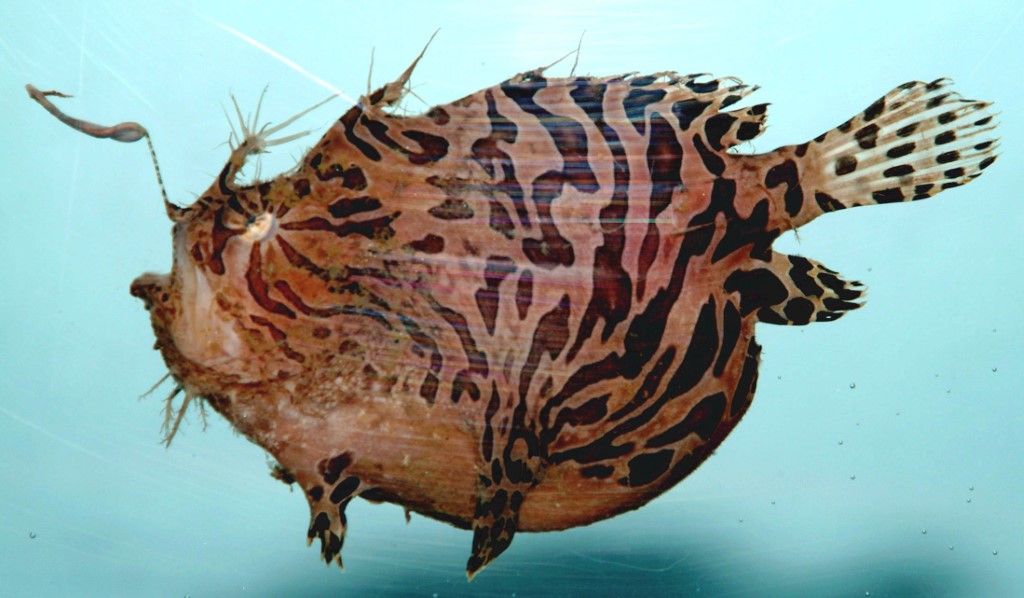 © Wikimedia.org/NOAA, CC0
© Wikimedia.org/NOAA, CC0
The arapaima, pirarucu, or paiche is any large species of bonytongue in the genus Arapaima native to the Amazon and Essequibo basins of South America. Arapaima is the type genus of the subfamily Arapaiminae within the family Osteoglossidae. They are among the world's largest freshwater fish, reaching as much as 3 m (9.8 ft) in length. They are an important food fish. They have declined in the native range due to overfishing and habitat loss. In contrast, arapaima have been introduced to several tropical regions outside the native range (within South America and elsewhere), where they are sometimes considered invasive species. In Kerala, India, Arapaima escaped from aquaculture ponds after floods in 2018. Its Portuguese name, pirarucu, derives from the Tupi language words pira and urucum, meaning 'red fish'. (Source: Wikipedia.org, CC BY-SA)
The Asian arowana (Scleropages formosus) comprises several phenotypic varieties of freshwater fish distributed geographically across Southeast Asia. While most consider the different varieties to belong to a single species, work by Pouyaud et al. (2003) differentiates these varieties into multiple species. They have several other common names, including Asian bonytongue, dragonfish, and a number of names specific to the different color varieties. Native to Southeast Asia, Asian arowanas inhabit blackwater rivers, slow-moving waters flowing through forested swamps and wetlands. Adults feed on other fish, while juveniles feed on insects. (Source: Wikipedia.org, CC BY-SA)
The Atlantic salmon (Salmo salar) is a species of ray-finned fish in the family Salmonidae. It is the third largest of the Salmonidae, behind Siberian taimen and Pacific Chinook salmon, growing up to a meter in length. Atlantic salmon are found in the northern Atlantic Ocean and in rivers that flow into it. Most populations are anadromous, hatching in streams and rivers but moving out to sea as they grow where they mature, after which the adults seasonally move upstream again to spawn. When the mature fish re-enter rivers to spawn, they change in colour and appearance. Some populations of this fish only migrate to large lakes, and are 'landlocked', spending their entire lives in freshwater. Such populations are found throughout the range of the species. Unlike Pacific species of salmon, S. salar is iteroparous, which means it can survive spawning and return to sea to repeat the process again in another year. Such individuals can grow to extremely large sizes, although they are rare. The different life stages of the fish are known by many different names in English: alevin, fry, parr and smolt. (Source: Wikipedia.org, CC BY-SA)
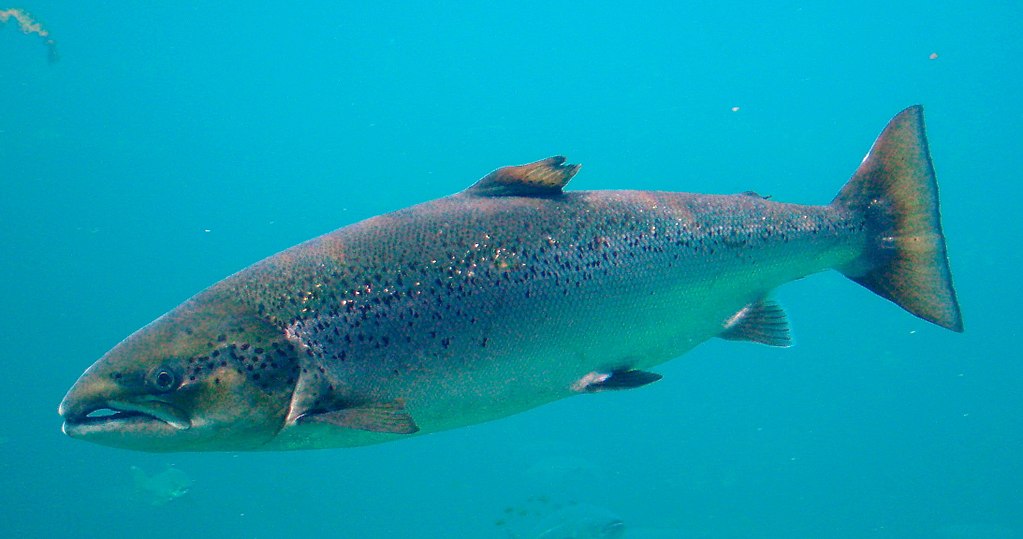 © Wikimedia.org/Hans-Petter Fjeld, CC BY-SA
© Wikimedia.org/Hans-Petter Fjeld, CC BY-SA
The baiji (Chinese: 白鱀豚; pinyin: báijìtún; IPA: [pǎɪtɕîtʰwə̌n] ; Lipotes vexillifer, Lipotes meaning 'left behind' and vexillifer 'flag bearer') is a possibly extinct species of freshwater dolphin native to the Yangtze river system in China. It is thought to be the first dolphin species driven to extinction due to the impact of humans. This dolphin is listed as “critically endangered: possibly extinct” by the IUCN, has not been seen in 20 years, and several surveys of the Yangtze have failed to find it. In China, the species is also called the Chinese river dolphin, Yangtze river dolphin, Yangtze dolphin and whitefin dolphin. Nicknamed the 'Goddess of the Yangtze' (simplified Chinese: 长江女神; traditional Chinese: 長江女神; pinyin: Cháng Jiāng nǚshén), it was regarded as the goddess of protection by local fishermen and boatmen. It is not to be confused with the Chinese white dolphin (Sousa chinensis) or the finless porpoise (Neophocaena phocaenoides). (Source: Wikipedia.org, CC BY-SA)
The Aspredinidae are a small South American family of catfishes (order Siluriformes) also known as the banjo catfishes, with about 43 species. The common name of the family 'banjo catfishes' refers to their overall body shape, with a depressed head and slender caudal peduncle, that in some species gives the appearance of a banjo. Banjo catfishes lack an adipose fin. Most species lack the dorsal spine-locking mechanism. Though their bodies are scaleless, their skin is completely keratinized and is covered by large, unculiferous tubercles arranged in longitudinal rows; the entire outer layer of skin may be shed. Size ranges from less than 2.0 centimetres (.79 in) SL in Hoplomyzon papillatus to Aspredo aspredo at about 38 centimetres (15 in) SL, though most are less than 15 cm. Most species exhibit cryptic coloration. Aspredinids have a loss of alarm cells and the fright reaction that is present in other ostariophysans. (Source: Wikipedia.org, CC BY-SA)
 © Wikimedia.org/M0N73R0, CC BY-SA
© Wikimedia.org/M0N73R0, CC BY-SA
A barb is one of various ray-finned fish species in a non-phylogenetic group, with members in the family Cyprinidae, and especially the genera Barbus and Puntius, but many others also. They were formerly united with the barbels in the subfamily Barbinae but that group is paraphyletic with the Cyprininae. If the Labeoninae are recognized as distinct, many small African 'barbs' would probably, however, warrant recognition as a new subfamily. (Source: Wikipedia.org, CC BY-SA)
A barracuda, or cuda for short, is a large, predatory, ray-finned fish known for its fearsome appearance and ferocious behaviour. The barracuda is a saltwater fish of the genus Sphyraena, the only genus in the family Sphyraenidae, which was named by Constantine Samuel Rafinesque in 1815. It is found in tropical and subtropical oceans worldwide ranging from the eastern border of the Atlantic Ocean to the Red Sea, on its western border the Caribbean Sea, and in tropical areas of the Pacific Ocean. Barracudas reside near the top of the water and near coral reefs and sea grasses. Barracudas are targeted by sport-fishing enthusiasts. (Source: Wikipedia.org, CC BY-SA)
The barramundi (Lates calcarifer) or Asian sea bass, is a species of catadromous fish in the family Latidae of the order Perciformes. The species is widely distributed in the Indo-West Pacific, spanning the waters of the Middle East, South Asia, Southeast Asia, East Asia, and Oceania. This species has an elongated body form with a large, slightly oblique mouth and an upper jaw extending behind the eye. The lower edge of the preoperculum is serrated with a strong spine at its angle; the operculum has a small spine and a serrated flap above the origin of the lateral line. Its scales are ctenoid. In cross section, the fish is compressed and the dorsal head profile clearly concave. (Source: Wikipedia.org, CC BY-SA)
The basking shark (Cetorhinus maximus) is the second-largest living shark and fish, after the whale shark, and one of three plankton-eating shark species, along with the whale shark and megamouth shark. Adults typically reach 7.9 m (26 ft) in length. It is usually greyish-brown, with mottled skin, with the inside of the mouth being white in color. The caudal fin has a strong lateral keel and a crescent shape. Other common names include bone shark, elephant shark, sail-fish, and sun-fish. In Orkney, it is commonly known as hoe-mother (sometimes contracted to homer), meaning 'the mother of the pickled dog-fish'. (Source: Wikipedia.org, CC BY-SA)
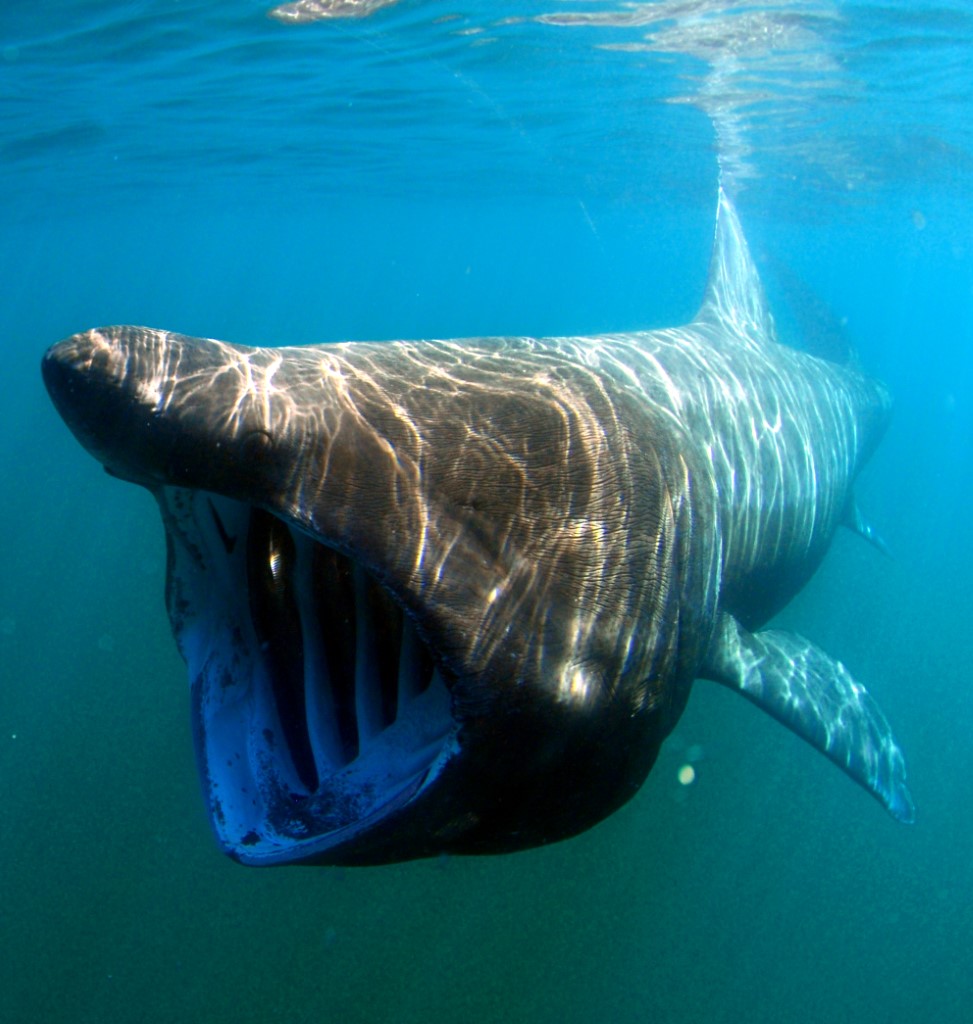 © Wikimedia.org/Greg Skomal, CC0
© Wikimedia.org/Greg Skomal, CC0
Ogcocephalidae is a family of anglerfish specifically adapted for a benthic lifestyle of crawling about on the seafloor. Ogcocephalid anglerfish are sometimes referred to as batfishes, deep-sea batfishes, handfishes, and seabats. They are found in tropical and subtropical oceans worldwide. They are mostly found at depths between 200 and 3,000 m (660 and 9,840 ft), but have been recorded as deep as 4,000 m (13,000 ft). A few species live in much shallower coastal waters and, exceptionally, may enter river estuaries. (Source: Wikipedia.org, CC BY-SA)
The beluga (/bəˈluːɡə/), also known as the beluga sturgeon or great sturgeon (Huso huso), is a species of anadromous fish in the sturgeon family (Acipenseridae) of order Acipenseriformes. It is found primarily in the Caspian and Black Sea basins, and formerly in the Adriatic Sea. Based on maximum size, it is the third-most-massive living species of bony fish. Heavily fished for the female's valuable roe, known as beluga caviar, wild populations have been greatly reduced by overfishing and poaching, leading IUCN to classify the species as critically endangered. (Source: Wikipedia.org, CC BY-SA)
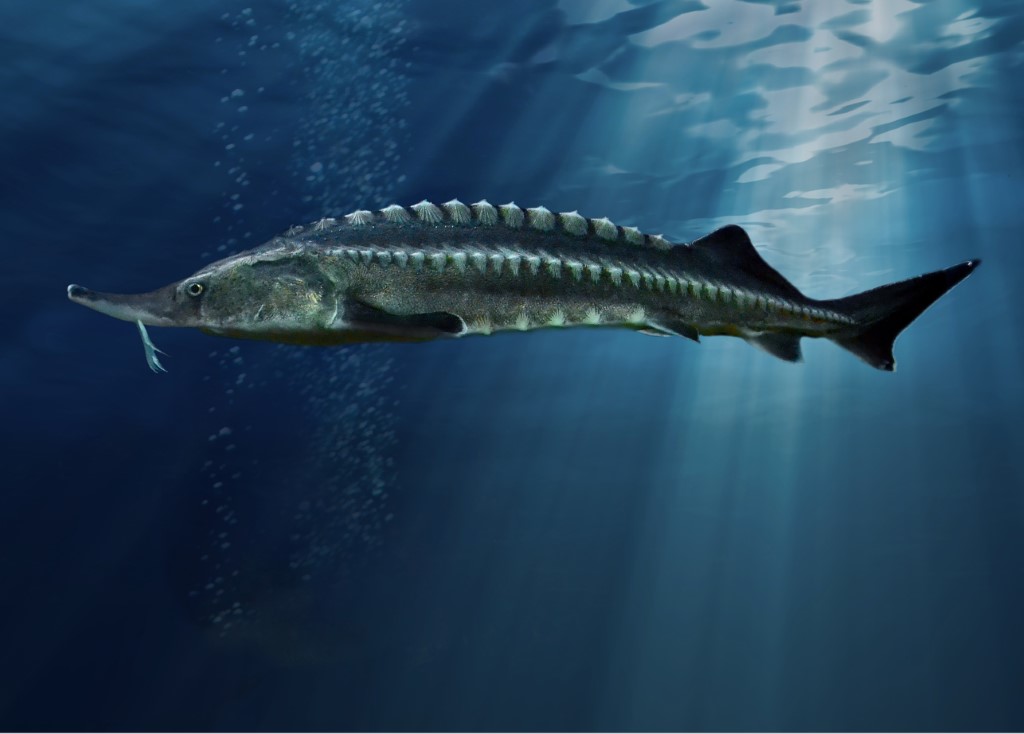 © Wikimedia.org/Максим Яковлєв, CC BY-SA
© Wikimedia.org/Максим Яковлєв, CC BY-SA
Betta /ˈbɛtə/ is a large genus of small, active, often colorful, freshwater ray-finned fishes, in the gourami family (Osphronemidae). The best known Betta species is B. splendens, commonly known as the Siamese fighting fish and often kept as an aquarium pet. All Betta species are small fishes, but they vary considerably in size, ranging from under 2.5 cm (1 in) total length in B. chanoides to 14 cm (5.5 in) in the Akar betta (B. akarensis). (Source: Wikipedia.org, CC BY-SA)
The black marlin (Istiompax indica) is a species of marlin found in tropical and subtropical areas of the Indian and Pacific Oceans. With a maximum published length of 4.65 m (15.3 ft) and weight of 750 kg (1,650 lb), it is one of the largest marlins and also one of the largest bony fish. Marlin are among the fastest fish, but speeds are often wildly exaggerated in popular media, such as reports of 132 km/h (82 mph). Recent research suggests a burst speed of 36 kilometres per hour (22 mph) is near the maximum rate. Black marlin are fished commercially and are also a highly prized game fish. Black marlins have been known to drag Maldivian fishing boats of the ancient times for very long distances until it got tired; and then it would then take many hours for the fishermen to row or sail back home. (Source: Wikipedia.org, CC BY-SA)
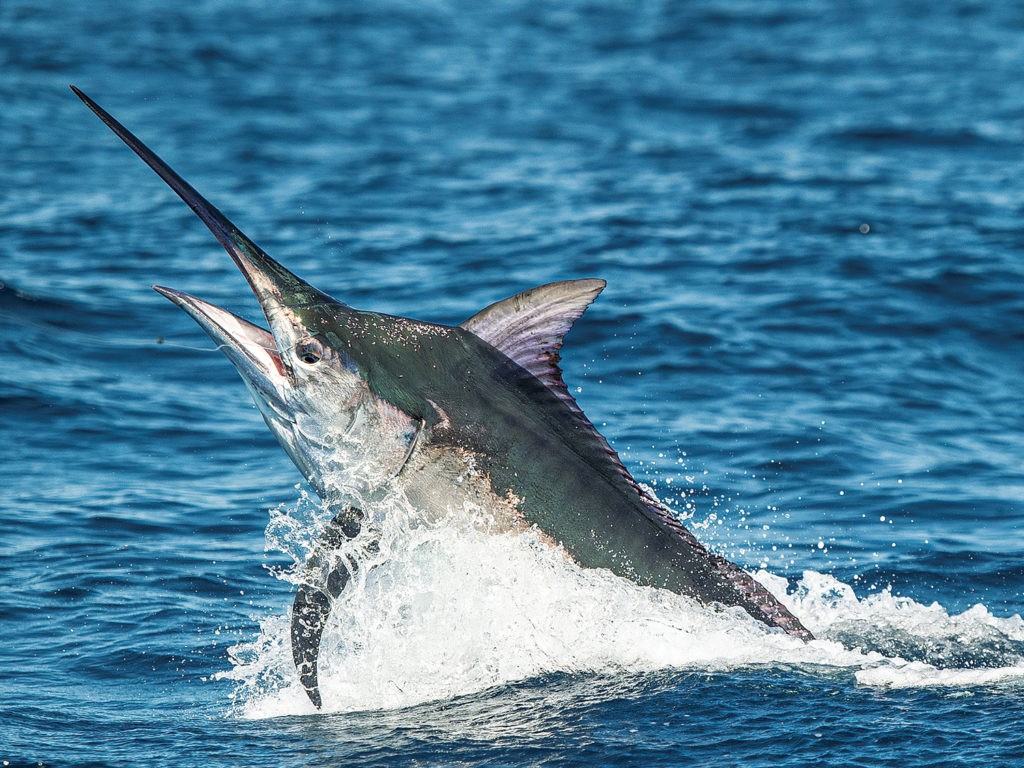 © Wikimedia.org/NOAA, CC0
© Wikimedia.org/NOAA, CC0
The fish family Psychrolutidae (commonly known as blobfishes, toadfishes, flathead sculpins, tadpole sculpins,) contains over 35 recognized species in 8 genera. This family consists of bottom-dwelling marine sculpins shaped like tadpoles, with large heads and bodies that taper back into small, flat tails. The skin is loosely attached and movable, and the layer underneath it is gelatinous. The eyes are placed high on the head, focused forward closer to the tip of the snout. Members of the family generally have large, leaf-like pectoral fins and lack scales, although some species are covered with soft spines. This is important to the species as the depths in which they live are highly pressurized and they are ambush/opportunistic/foraging predators that do not expend energy unless they are forced to. The blobfish has a short, broad tongue and conical teeth that are slightly recurved and are arranged in bands in irregular rows along the premaxillaries; canines are completely absent. Teeth are nonexistent on the palatines and vomer; which make up the hard palate. The blobfish also has a set of specialized pharyngeal teeth that are well developed and paired evenly along the upper and lower portions of the pharyngeal arch. These specialized teeth may aid in the breakdown of food due to the very strategic dependency on whatever food falls from above. (Source: Wikipedia.org, CC BY-SA)
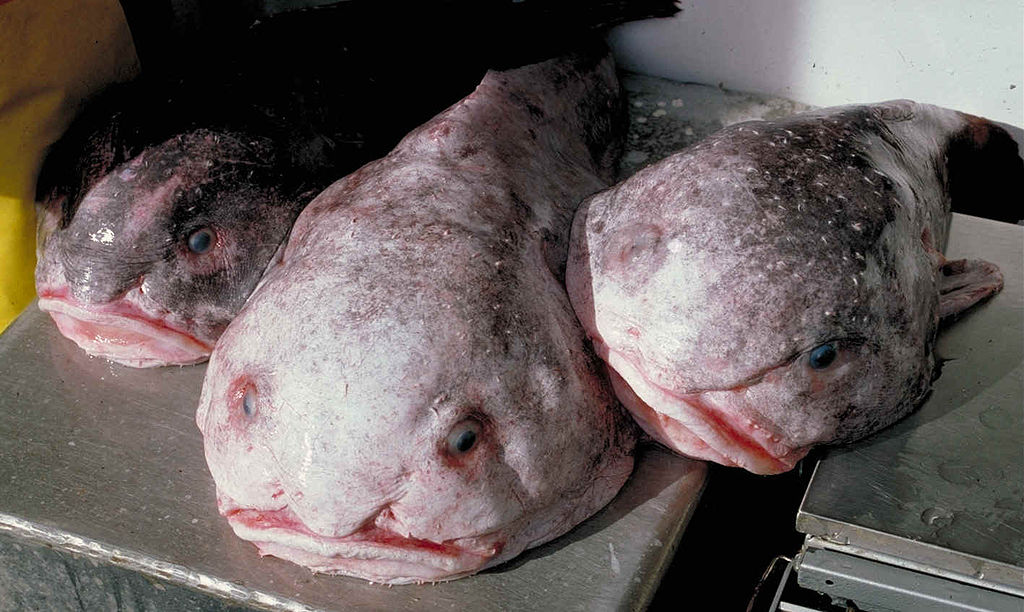 © Wikimedia.org, CC0
© Wikimedia.org, CC0
The blue catfish (Ictalurus furcatus) is the largest species of North American catfish, reaching a length of 165 cm (65 in) and a weight of 68 kg (150 lb). The typical length is about 25–46 in (64–117 cm). The fish can live to 20 years. The native distribution of blue catfish is primarily in the Mississippi River drainage, including the Missouri, Ohio, Tennessee, and Arkansas Rivers, The Des Moines River in South Central Iowa, and the Rio Grande, and south along the Gulf Coast to Belize and Guatemala. These large catfish have also been introduced in a number of reservoirs and rivers, notably the Santee Cooper lakes of Lake Marion and Lake Moultrie in South Carolina, the James River in Virginia, Powerton Lake in Pekin, Illinois, and Lake Springfield in Springfield, Illinois. This fish is also found in some lakes in Florida. The fish is considered an invasive pest in some areas, particularly the Chesapeake Bay. Blue catfish can tolerate brackish water, thus can colonize along inland waterways of coastal regions. (Source: Wikipedia.org, CC BY-SA)
The blue shark (Prionace glauca), also known as the great blue shark, is a species of requiem shark, in the family Carcharhinidae, which inhabits deep waters in the world's temperate and tropical oceans. Averaging around 3.1 m (10 ft) and preferring cooler waters, the blue shark migrates long distances, such as from New England to South America. It is listed as Near Threatened by the IUCN. Although generally lethargic, they can move very quickly. Blue sharks are viviparous and are noted for large litters of 25 to over 100 pups. They feed primarily on small fish and squid, although they can take larger prey. Maximum lifespan is still unknown, but it is believed that they can live up to 20 years. (Source: Wikipedia.org, CC BY-SA)
The Atlantic bluefin tuna (Thunnus thynnus) is a species of tuna in the family Scombridae. It is variously known as the northern bluefin tuna (mainly when including Pacific bluefin as a subspecies), giant bluefin tuna [for individuals exceeding 150 kg (330 lb)], and formerly as the tunny. Atlantic bluefins are native to both the western and eastern Atlantic Ocean, as well as the Mediterranean Sea. They have become extinct in the Black Sea. The Atlantic bluefin tuna is a close relative of the other two bluefin tuna species—the Pacific bluefin tuna and the southern bluefin tuna. (Source: Wikipedia.org, CC BY-SA)
The bluegill (Lepomis macrochirus), sometimes referred to as 'bream', 'brim', 'sunny', or 'copper nose' as is common in Texas, is a species of North American freshwater fish, native to and commonly found in streams, rivers, lakes, ponds and wetlands east of the Rockies. It is the type species of the genus Lepomis (true sunfish), from the family Centrarchidae (sunfishes, crappies and black basses) in the order Perciformes (perch-like fish). Bluegills can grow up to 12 in (30 cm) long and about 4+1⁄2 lb (2.0 kg). While their color can vary from population to population, they typically have a very distinctive coloring, with deep blue and purple on the face and gill cover, dark olive-colored bands down the side, and a fiery orange to yellow belly. They are omnivorous and will consume anything they can fit in their mouth, but mostly feed on small aquatic insects and baitfishes. (Source: Wikipedia.org, CC BY-SA)
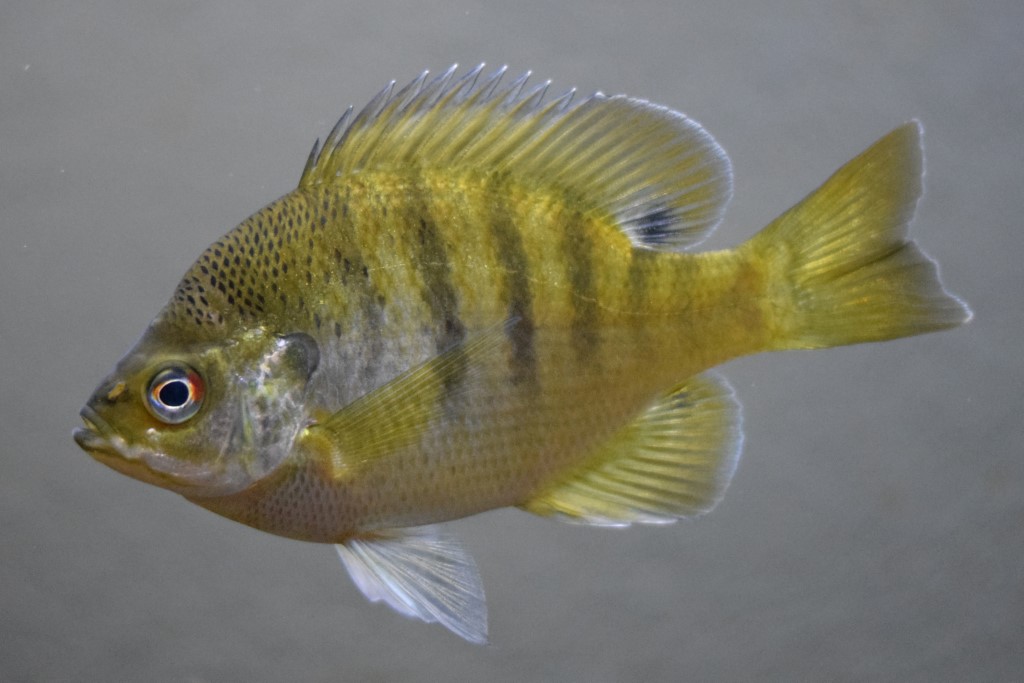 © Wikimedia.org/Scott Harden, CC BY-SA
© Wikimedia.org/Scott Harden, CC BY-SA
The little tunny (Euthynnus alletteratus), also known as the false albacore, little tuna, bonita, bonito, or blue bonito, is a species of tuna in the family Scombridae. It can be found in the Atlantic Ocean and the Mediterranean and Black seas; in the western Atlantic, it ranges from Brazil to the New England states. The little tunny is a pelagic fish that can be found regularly in both offshore and inshore waters, and it is classified as a highly migratory species. The little tunny is best identified by the 'worm-like' markings on its back and the dark spots appearing between its pectoral and ventral fins. (Source: Wikipedia.org, CC BY-SA)
The bonnethead shark (Sphyrna tiburo), also called the bonnet shark or shovelhead, is a small member of the hammerhead shark genus Sphyrna, and part of the family Sphyrnidae. It is an abundant species in the littoral zone of the North Atlantic and the Gulf of Mexico, is the only shark species known to display sexual dimorphism in the morphology of the head, and is the only shark species known to be omnivorous. (Source: Wikipedia.org, CC BY-SA)
The bowfin (Amia calva) is a bony fish, native to North America. Common names include mudfish, mud pike, dogfish, grindle, grinnel, swamp trout, and choupique. It is regarded as a relict, being the sole surviving species of the Halecomorphi, a group of fish that first appeared during the Early Triassic, around 250 million years ago. The bowfin is often considered a 'primitive fish' because they have retained some morphological characteristics of their early ancestors. The closest living relatives of bowfins are gars, with the two groups being united in the clade Holostei. (Source: Wikipedia.org, CC BY-SA)
 © Wikimedia.org/Stan Shebs, CC BY-SA
© Wikimedia.org/Stan Shebs, CC BY-SA
Ostraciidae is a family of squared, bony fish belonging to the order Tetraodontiformes, closely related to the pufferfishes and filefishes. Fish in the family are known variously as boxfishes, cofferfishes, cowfishes and trunkfishes. It contains about 23 extant species in 6 extant genera. Members of this family occur in a variety of different colors, and are notable for the hexagonal or 'honeycomb' patterns on their skin. They swim in a rowing manner. Their hexagonal plate-like scales are fused together into a solid, triangular or box-like carapace, from which the fins, tail, eyes and mouth protrude. (Source: Wikipedia.org, CC BY-SA)
The bull shark (Carcharhinus leucas), also known as the Zambezi shark (informally zambi) in Africa and Lake Nicaragua shark in Nicaragua, is a species of requiem shark commonly found worldwide in warm, shallow waters along coasts and in rivers. It is known for its aggressive nature, and presence mainly in warm, shallow brackish and freshwater systems including estuaries and lower reaches of rivers. Bull sharks are euryhaline and can thrive in both salt and fresh water. They are known to travel far up rivers, and have been known to travel up the Mississippi River as far as Alton, Illinois, about 1,100 kilometres (700 mi) from the ocean, but few freshwater interactions with humans have been recorded. Larger-sized bull sharks are probably responsible for the majority of nearshore shark attacks, including many incidents of shark bites attributed to other species. (Source: Wikipedia.org, CC BY-SA)
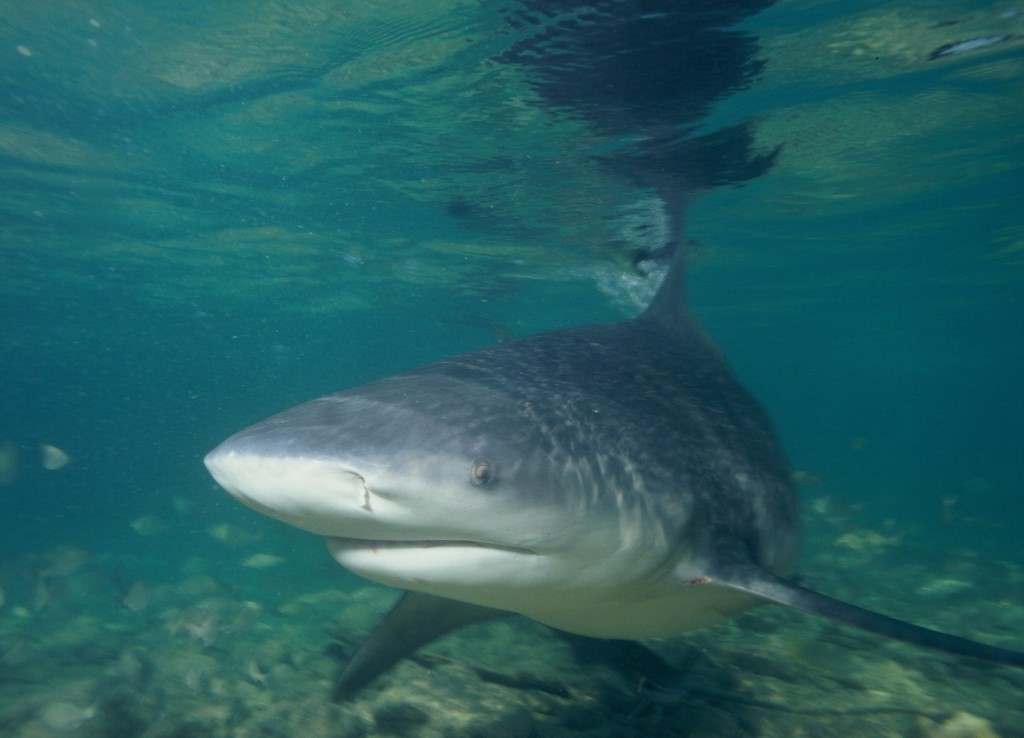 © Wikimedia.org/Albert kok, CC0
© Wikimedia.org/Albert kok, CC0
The bull trout (Salvelinus confluentus) is a char of the family Salmonidae native to northwestern North America. Historically, S. confluentus has been known as the 'Dolly Varden' (S. malma), but was reclassified as a separate species in 1980. Bull trout are listed as a threatened species under the U.S. Endangered Species Act (1998) and as vulnerable on the IUCN Red List of Threatened Species. Like other species of char, the fins of a bull trout have white leading edges. Its head and mouth are unusually large for salmonids, giving it its name. Bull trout have been recorded measuring up to 103 cm (41 in) in length and weighing 14.5 kg (32 lb). Bull trout may be either migratory, moving throughout large river systems, lakes, and the ocean, or they may be resident, remaining in the same stream their entire lives. (Source: Wikipedia.org, CC BY-SA)
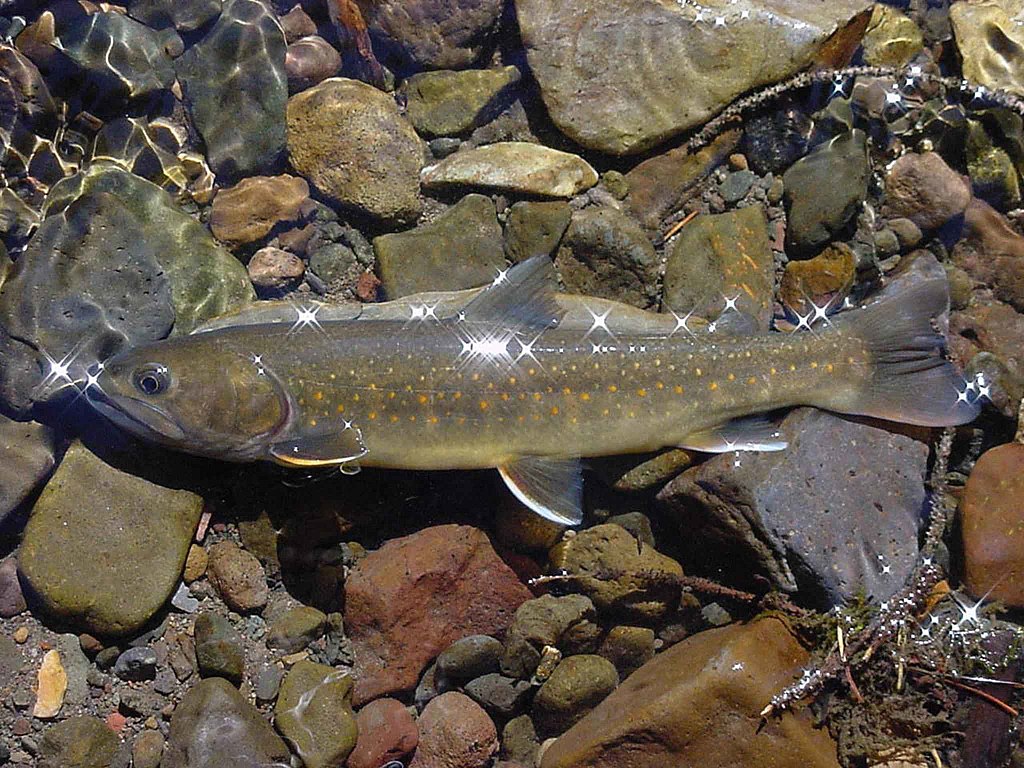 © Wikimedia.org/Bart Gammet, CC0
© Wikimedia.org/Bart Gammet, CC0
The butterflyfish are a group of conspicuous tropical marine fish of the family Chaetodontidae; the bannerfish and coralfish are also included in this group. The approximately 129 species in 12 genera are found mostly on the reefs of the Atlantic, Indian, and Pacific Oceans. A number of species pairs occur in the Indian and Pacific Oceans, members of the huge genus Chaetodon. Butterflyfish look like smaller versions of angelfish (Pomacanthidae), but unlike these, lack preopercle spines at the gill covers. Some members of the genus Heniochus resemble the Moorish idol (Zanclus cornutus) of the monotypic Zanclidae. Among the paraphyletic Perciformes, the former are probably not too distantly related to butterflyfish, whereas the Zanclidae seem far less close. (Source: Wikipedia.org, CC BY-SA)
 © Wikimedia.org/JSutton93, CC BY-SA
© Wikimedia.org/JSutton93, CC BY-SA
Carp are various species of oily freshwater fish from the family Cyprinidae, a very large group of fish native to Europe and Asia. While carp is consumed in many parts of the world, they are generally considered an invasive species in parts of Africa, Australia and most of the United States. Various species of carp have been domesticated and reared as food fish across Europe and Asia for thousands of years. These various species appear to have been domesticated independently, as the various domesticated carp species are native to different parts of Eurasia. Aquaculture has been pursued in China for at least 2,400 years. (Source: Wikipedia.org, CC BY-SA)
Catfish (or catfishes; order Siluriformes /sɪˈljʊərɪfɔːrmiːz/ or Nematognathi) are a diverse group of ray-finned fish. Named for their prominent barbels, which resemble a cat's whiskers, catfish range in size and behavior from the three largest species alive, the Mekong giant catfish from Southeast Asia, the wels catfish of Eurasia, and the piraíba of South America, to detritivores (species that eat dead material on the bottom), and even to a tiny parasitic species commonly called the candiru, Vandellia cirrhosa. Neither the armour-plated types nor the naked types have scales. Despite their name, not all catfish have prominent barbels or 'whiskers'. Members of the Siluriformes order are defined by features of the skull and swimbladder. Catfish are of considerable commercial importance; many of the larger species are farmed or fished for food. Many of the smaller species, particularly the genus Corydoras, are important in the aquarium hobby. Many catfish are nocturnal, but others (many Auchenipteridae) are crepuscular or diurnal (most Loricariidae or Callichthyidae, for example). (Source: Wikipedia.org, CC BY-SA)
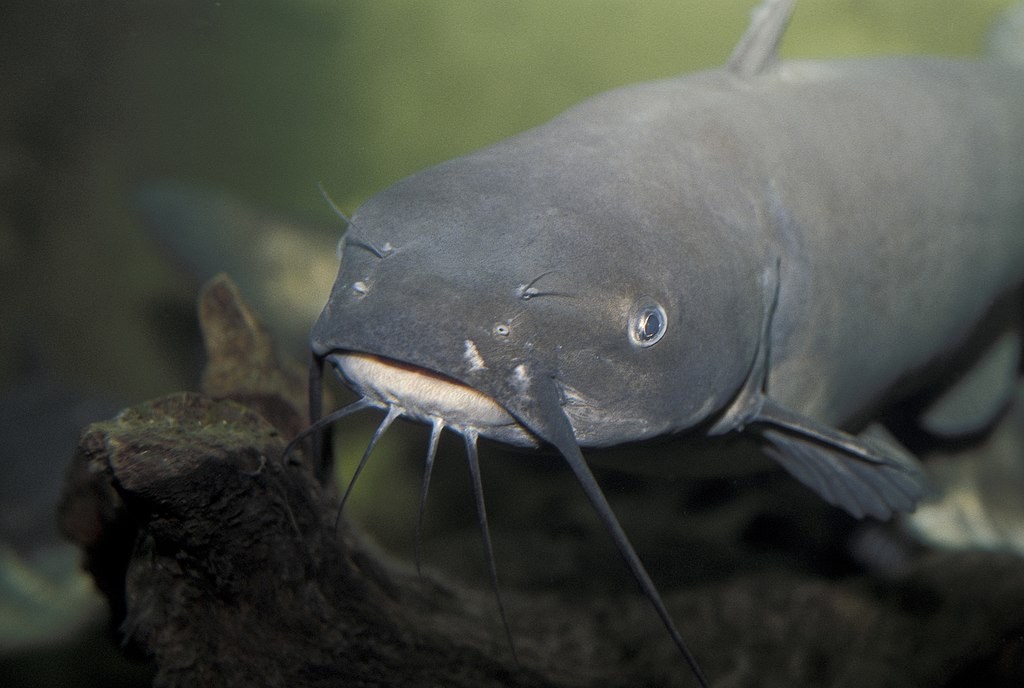 © Wikimedia.org/Missouri State Archives, CC0
© Wikimedia.org/Missouri State Archives, CC0
Chimaeras are cartilaginous fish in the order Chimaeriformes /kɪˈmɛrɪfɔːrmiːz/, known informally as ghost sharks, rat fish, spookfish, or rabbit fish; the last three names are not to be confused with rattails, Opisthoproctidae, or Siganidae, respectively. At one time a 'diverse and abundant' group (based on the fossil record), their closest living relatives are sharks and rays, though their last common ancestor with them lived nearly 400 million years ago. Today, they are largely confined to deep water. (Source: Wikipedia.org, CC BY-SA)
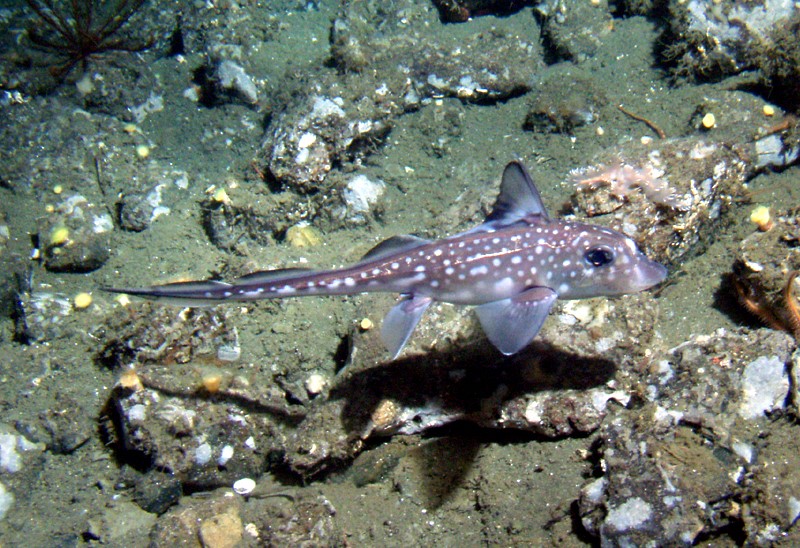 © Wikimedia.org/Linda Snook, CC0
© Wikimedia.org/Linda Snook, CC0
The Chinese paddlefish (Psephurus gladius; simplified Chinese: 白鲟; traditional Chinese: 白鱘; pinyin: báixún: literal translation: 'white sturgeon'), also known as the Chinese swordfish, is an extinct species of fish that was formerly native to the Yangtze and Yellow River basins in China. With records of specimens over three metres (ten feet) and possibly 7 m (23 ft) in length, it was one of the largest species of freshwater fish. It was the only species in the genus Psephurus and one of two recent species of paddlefish (Polyodontidae), the other being the American paddlefish (Polyodon spathula). It was an anadromous species, meaning that it spent part of its adult life at sea, while migrating upriver to spawn. (Source: Wikipedia.org, CC BY-SA)
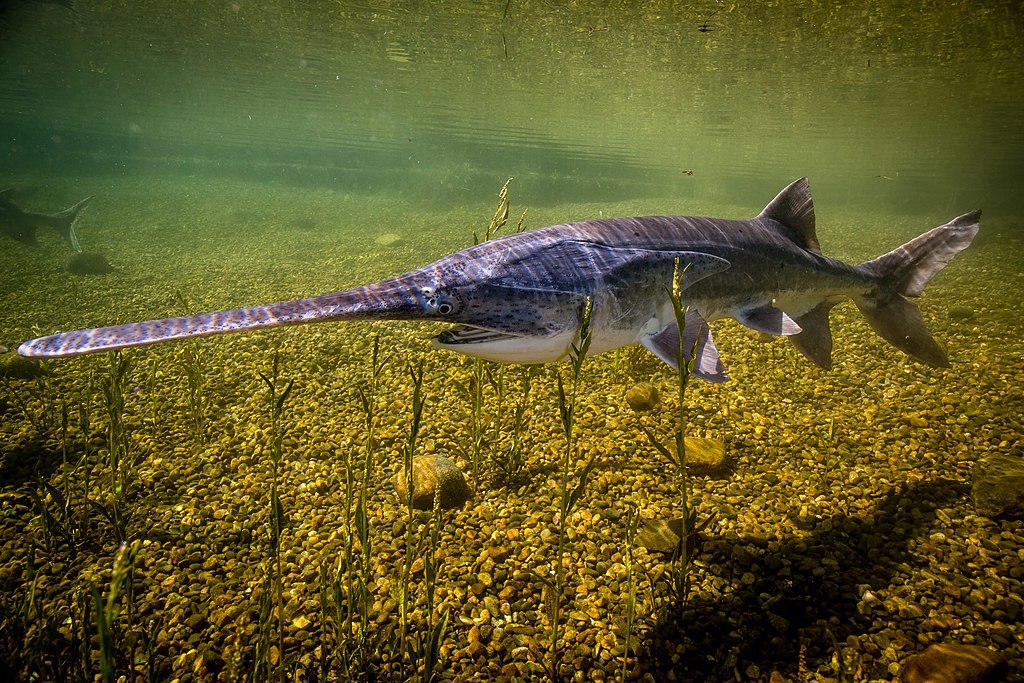 © Wikimedia.org/U.S. Fish and Wildlife Service, CC0
© Wikimedia.org/U.S. Fish and Wildlife Service, CC0
The Chinook salmon /ʃɪˈnʊk/ (Oncorhynchus tshawytscha) is the largest and most valuable species of Pacific salmon in North America, as well as the largest in the genus Oncorhynchus. Its common name is derived from the Chinookan peoples. Other vernacular names for the species include king salmon, Quinnat salmon, Tsumen, spring salmon, chrome hog, Blackmouth, and Tyee salmon. The scientific species name is based on the Russian common name chavycha (чавыча). (Source: Wikipedia.org, CC BY-SA)
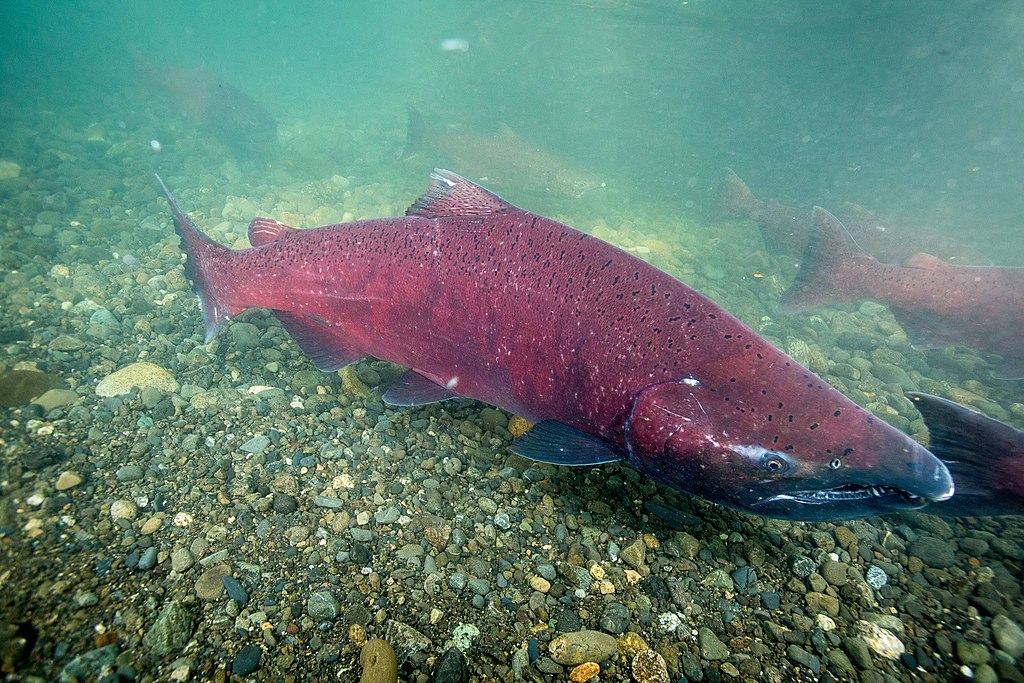 © Wikimedia.org/United States Fish and Wildlife Services, CC0
© Wikimedia.org/United States Fish and Wildlife Services, CC0
Cichlids /ˈsɪklɪdz/ are fish from the family Cichlidae in the order Cichliformes. Cichlids were traditionally classed in a suborder, the Labroidei, along with the wrasses (Labridae), in the order Perciformes, but molecular studies have contradicted this grouping. The closest living relative of cichlids is probably the convict blenny, and both families are classified in the 5th edition of Fishes of the World as the two families in the Cichliformes, part of the subseries Ovalentaria. This family is both large and diverse. At least 1,650 species have been scientifically described, making it one of the largest vertebrate families. New species are discovered annually, and many species remain undescribed. The actual number of species is therefore unknown, with estimates varying between 2,000 and 3,000. (Source: Wikipedia.org, CC BY-SA)
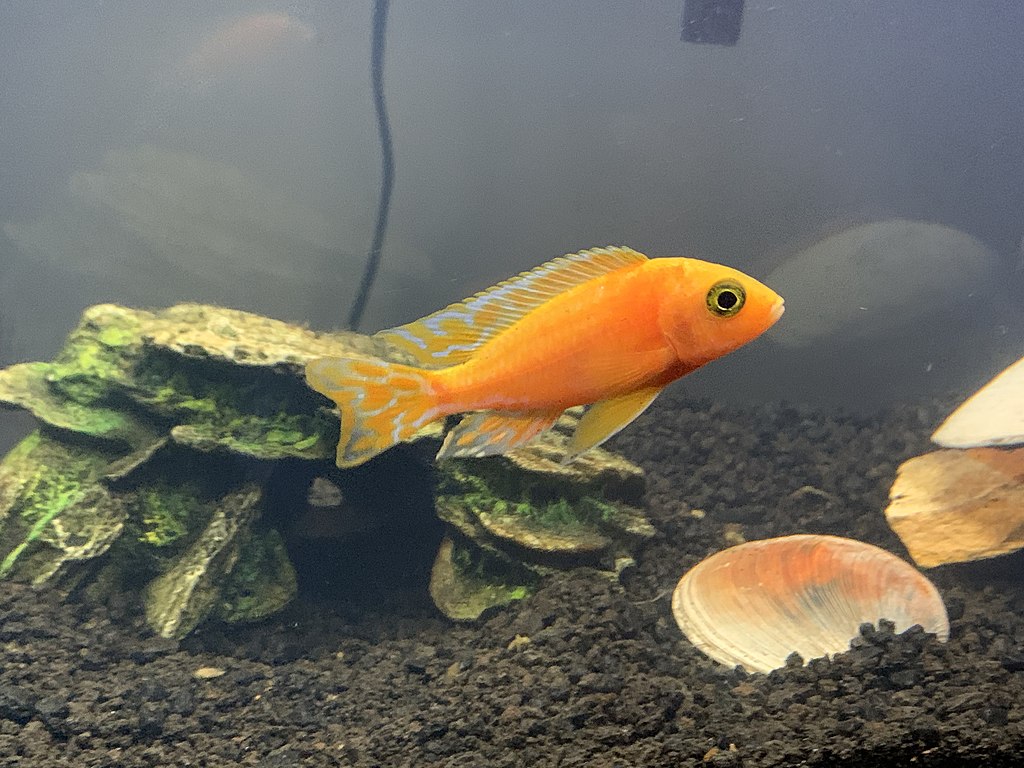 © Wikimedia.org/Dynen, CC BY-SA
© Wikimedia.org/Dynen, CC BY-SA
Clownfish or anemonefish are fishes from the subfamily Amphiprioninae in the family Pomacentridae. Thirty species of clownfish are recognized: one in the genus Premnas, while the remaining are in the genus Amphiprion. In the wild, they all form symbiotic mutualisms with sea anemones. Depending on the species, anemonefish are overall yellow, orange, or a reddish or blackish color, and many show white bars or patches. The largest can reach a length of 17 cm (6+1⁄2 in), while the smallest barely achieve 7–8 cm (2+3⁄4–3+1⁄4 in). (Source: Wikipedia.org, CC BY-SA)
The cobia (Rachycentron canadum) is a species of carangiform marine fish, the only extant representative of the genus Rachycentron and the family Rachycentridae. Other common names include black kingfish, black salmon, ling, lemonfish, crabeater, prodigal son, codfish and black bonito. Attaining a maximum length of 2 m (78 in) and maximum weight of 78 kg (172 lb), the cobia has an elongated, fusiform (spindle-shaped) body and a broad, flattened head. The eyes are small and the lower jaw projects slightly past the upper. Fibrous villiform teeth line the jaws, the tongue, and the roof of the mouth. The body of the fish is smooth with small scales. It is dark brown in color, grading to white on the belly with two darker brown horizontal bands on the flanks. The stripes are more prominent during spawning, when they darken and the background color flashes. (Source: Wikipedia.org, CC BY-SA)
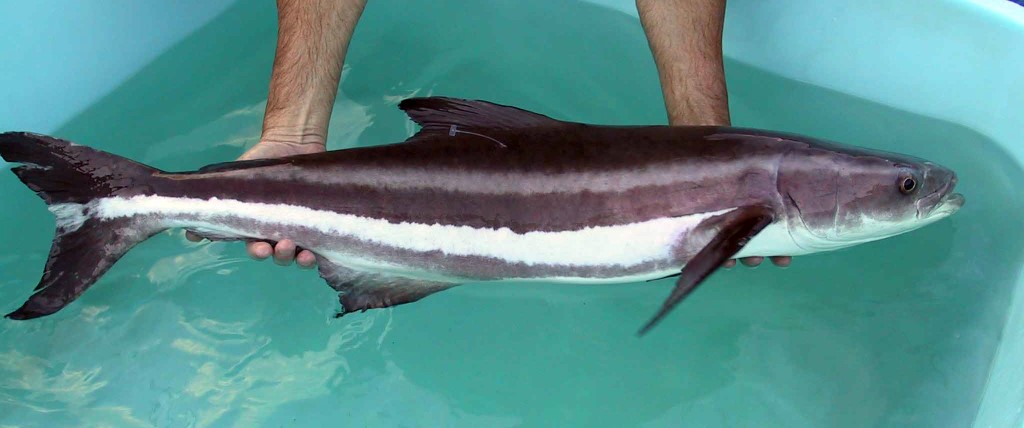 © Wikimedia.org, CC0
© Wikimedia.org, CC0
Cod is the common name for the demersal fish genus Gadus, belonging to the family Gadidae. Cod is also used as part of the common name for a number of other fish species, and one species that belongs to genus Gadus is commonly not called cod (Alaska pollock, Gadus chalcogrammus). The two most common species of cod are the Atlantic cod (Gadus morhua), which lives in the colder waters and deeper sea regions throughout the North Atlantic, and the Pacific cod (Gadus macrocephalus), found in both eastern and western regions of the northern Pacific. Gadus morhua was named by Linnaeus in 1758. (Source: Wikipedia.org, CC BY-SA)

Time for recess! Post a comment, ask a question or write a review. Feel free to let us know what you think!
Ben fransada turkce deralere girecem ehliyet ici sinavlari bilen bana yardimci olur mu
Mrhaba bu hafta yaziliya girecem bana yardimci olmak isteyen varmi isvec yazilisina cok korkuyorum yalniz
Orda tabela var otoban başlangıçı icin sorular bunlar Otoyolun başlangıçı Park etmek yasaktır Otobanın başlangıcı Giriş yapmak yasaktır Ben otobanın başlangıçı basıyom yok yanlışmiş otoyolun başlangıçıymız tabi biz türkiyede yaşıyoz unutum ben amk
Elinize sağlık Türkiye'de olmayan birçok levha var.Mantık yürüterek dogru cevapları bulmaya çalıştım.
Gercekten emeginize saglık. Alakasız ve yanlıs birsürü testle karşılaştım, sonunda faydalı bir sayfaya denk geldim.
Merhaba benim Türk ehliyetim var Romanya ehliyeti ile değiştirmek istiyorum nasıl yapabilirim
Dun sinava girdim tek bir soruyla kaybettim dogru bildim konturol ettim 3 soruyu yannis ciklarla cevirdim
HAZIRLAYANLARDAN ALLAH RAZI OLSUN IN$LLH COK GÜZEL-TEK SIKINTI COK AZ TÜRKCE CEVIRIMLERDE AMA OLSUN BEN COK BEGENDIM TE$EKKÜRLER
Bazı sorularda yazımı da aynı olan 2 aynı doğru cevap var. Örnek: Yayalar için yolun sonu. Yerleşim alanının sonu. Bir yerleşim alanının başlangıcı. Yerleşim alanının sonu.